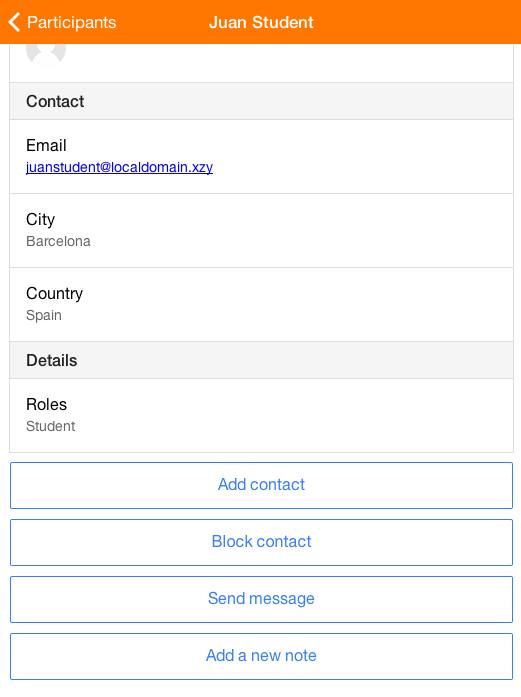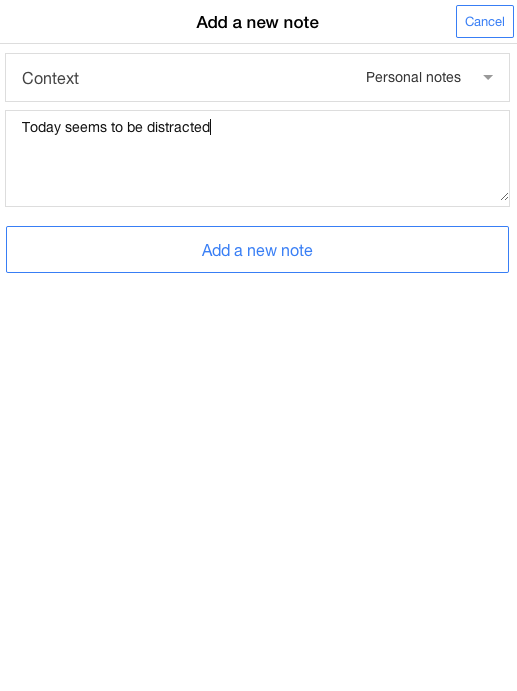Moodle Mobile 2 (Ionic 1) Developing a plugin tutorial: Difference between revisions
Juan Leyva (talk | contribs) |
Juan Leyva (talk | contribs) |
||
| Line 62: | Line 62: | ||
'''www/addons/notes/services/handlers.js''' | '''www/addons/notes/services/handlers.js''' | ||
<code javascript> | <code javascript> | ||
self.isEnabled = function() { | |||
return $mmaNotes.isPluginEnabled(); | |||
}; | |||
self.isEnabledForUser = function(user, courseId) { | |||
// Active course required. | |||
return courseId && user.id != $mmSite.getUserId(); | |||
}; | |||
</code> | </code> | ||
These are mandatory functions that will check our plugin availability, the first one will rely in the $mmaNotes service (isPluginEnabled function), the second ones checks that the user profile is being viewed inside a course (because the WS requires it) and that the current user is not the required user (so you don't see the buttons in your own profile). | |||
<code javascript> | |||
self.getController = function(user, courseid) { | |||
return function($scope) { | |||
// Button title. | |||
$scope.title = 'mma.notes.addnewnote'; | |||
$ionicModal.fromTemplateUrl('addons/notes/templates/add.html', { | |||
scope: $scope, | |||
animation: 'slide-in-up' | |||
}).then(function(m) { | |||
$scope.modal = m; | |||
}); | |||
$scope.closeModal = function(){ | |||
$scope.modal.hide(); | |||
}; | |||
$scope.addNote = function(){ | |||
// Freeze the add note button. | |||
$scope.processing = true; | |||
$mmaNotes.addNote(user.id, courseid, $scope.note.publishstate, $scope.note.text).then(function() { | |||
$translate('mma.notes.eventnotecreated').then(function(str) { | |||
$ionicLoading.show({ | |||
template: str, | |||
duration: 2000 | |||
}); | |||
}); | |||
}, function(error) { | |||
$mmUtil.showErrorModal(error); | |||
}).finally(function() { | |||
$scope.closeModal(); | |||
}); | |||
}; | |||
$scope.action = function($event) { | |||
$event.preventDefault(); | |||
$event.stopPropagation(); | |||
$scope.note = { | |||
publishstate: 'personal', | |||
text: '' | |||
}; | |||
$scope.processing = false; | |||
$scope.modal.show(); | |||
}; | |||
}; | |||
}; | |||
</code> | |||
These is the main function code, it does the following: | |||
* $scope.title = 'mma.notes.addnewnote'; This sets the button title, note that we reference to the addnewnote string that is in the www/addons/notes/lang/en.json file (we need to prefix the string id to identify the plugin) | |||
* $ionicModal.fromTemplateUrl - Creates the modal we are going to use for displaying the form, the HTML code of the form is in www/addons/notes/templates/add.html | |||
* $scope.closeModal - Helper function for closing the modal inside the modal via a button | |||
* $scope.addNote - This function will be called when the user clicks the "Add a note" button in the modal, it will use the $mmaNotes service that handles all the logic WS logic for creating the note | |||
* $scope.action - This function will be called when the user clicks the "Add a note" button in the user profile view, it will open the modal and set the default values | |||
== See also == | == See also == | ||
[[Moodle Mobile Developing a plugin tutorial part 2]] | [[Moodle Mobile Developing a plugin tutorial part 2]] | ||
Revision as of 13:20, 22 June 2015
Introduction
This tutorial describes all the steps needed for developing an add-on for the Moodle Mobile app.
In this tutorial we make the following assumptions:
- You have a medium/good skills/understand of AngularJS/Ionic, PHP and Moodle architecture
- You know what a Web Service is and how it works in Moodle
- The plugin you are going to develop requires a Web Service in your Moodle installation to work
There is a second part of this tutorial where we extend the add-on features Moodle Mobile Developing a plugin tutorial part 2
Add-on spec
We want to develop a plugin that will display a new button in the user profile for adding new notes to the user. This plugin is suitable for course managers of teachers.
A screenshot of the desired result:
Steps
Set up your development environment
Please, read Setting up your development environment for Moodle Mobile 2
Set up your Moodle installation
Enable debugging, disable caches, etc... the typical settings for developing.
Enable the Mobile Service via Admin / Plugins / Web Services / Mobile
Develop the Moodle Web Services you are going to need
In this case we'll use an existing web service (core_notes_create_notes) that is already available in the Moodle Mobile app service, if you need custom functions you will need to develop a local plugin including there your new Web Services (see https://moodle.org/plugins/view/local_wstemplate) and create a custom service.
Develop the Moodle Mobile plugin
The full source code can be found here: https://github.com/moodlehq/moodlemobile2/tree/master/www/addons/notes
www/addons/notes/main.js
angular.module('mm.addons.notes', [])
.run(function($mmUserDelegate, $mmaNotesHandlers) {
$mmUserDelegate.registerPlugin('mmaNotes:addNote', $mmaNotesHandlers.addNote);
});
Here we declare the plugin, and register the Plugin (this means that the plugin will be displayed in the User profile.
We will use the $mmaNotesHandlers service for holding all the code related to the plugin availability and main functions
There are more delegates for registering your plugin, see:
- www/addons/mod_forum/main.js (Module delegate, and module actions delegate)
- www/addons/messages/main.js (Main side menu delegate, and multiple delegates for the user profile)
www/addons/notes/services/handlers.js
self.isEnabled = function() {
return $mmaNotes.isPluginEnabled();
};
self.isEnabledForUser = function(user, courseId) {
// Active course required.
return courseId && user.id != $mmSite.getUserId();
};
These are mandatory functions that will check our plugin availability, the first one will rely in the $mmaNotes service (isPluginEnabled function), the second ones checks that the user profile is being viewed inside a course (because the WS requires it) and that the current user is not the required user (so you don't see the buttons in your own profile).
self.getController = function(user, courseid) {
return function($scope) {
// Button title.
$scope.title = 'mma.notes.addnewnote';
$ionicModal.fromTemplateUrl('addons/notes/templates/add.html', {
scope: $scope,
animation: 'slide-in-up'
}).then(function(m) {
$scope.modal = m;
});
$scope.closeModal = function(){
$scope.modal.hide();
};
$scope.addNote = function(){
// Freeze the add note button.
$scope.processing = true;
$mmaNotes.addNote(user.id, courseid, $scope.note.publishstate, $scope.note.text).then(function() {
$translate('mma.notes.eventnotecreated').then(function(str) {
$ionicLoading.show({
template: str,
duration: 2000
});
});
}, function(error) {
$mmUtil.showErrorModal(error);
}).finally(function() {
$scope.closeModal();
});
};
$scope.action = function($event) {
$event.preventDefault();
$event.stopPropagation();
$scope.note = {
publishstate: 'personal',
text:
};
$scope.processing = false;
$scope.modal.show();
};
};
};
These is the main function code, it does the following:
- $scope.title = 'mma.notes.addnewnote'; This sets the button title, note that we reference to the addnewnote string that is in the www/addons/notes/lang/en.json file (we need to prefix the string id to identify the plugin)
- $ionicModal.fromTemplateUrl - Creates the modal we are going to use for displaying the form, the HTML code of the form is in www/addons/notes/templates/add.html
- $scope.closeModal - Helper function for closing the modal inside the modal via a button
- $scope.addNote - This function will be called when the user clicks the "Add a note" button in the modal, it will use the $mmaNotes service that handles all the logic WS logic for creating the note
- $scope.action - This function will be called when the user clicks the "Add a note" button in the user profile view, it will open the modal and set the default values

